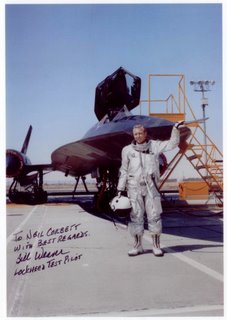Bill Weaver 1930-2021

Bill Weaver has flight-tested all models of the Mach-2 F-104 Starfighter and the entire family of Mach 3+ Blackbirds-the A-12, YF-12 and SR-71. He subsequently was assigned to Lockheed's L-1011 project as an engineering test pilot, became the company's chief pilot. He later retired as Division Manager of Commercial Flying Operations. He still flies Orbital Sciences Corp.'s L-1011, which has been modified to carry the Pegasus satellite-launch vehicle. And as an FAA Designated Engineering Representative Flight Test Pilot, he's also involved in various aircraft-modification projects, conducting certification flight tests.
Description of the loss of the SR-71A piloted by Bill Weaver which broke up at Mach 3 and 70,000ft
Loss #4 61-17952 (SR-71A) This aircraft disintegrated on 25 January 1966 during a high-speed, high-altitude test flight when it developed a severe case of engine un-start. This flight was to research and improve high mach cruise performance by reducing trim drag which would lower fuel burn and increase range. The un-start occurred during a turn at speeds above Mach 3.17 and a bank of 35 degrees. The bank immediately increased to 60 degrees; the nose pitched up and the aircraft broke apart at station 720. Lockheed pilot Bill Weaver was thrown clear (his ejection seat never left the plane) and he blacked out during the accident but recovered and landed on the ground safely. Tragically, his Reconnaissance System Officer (RSO), Jim Zwayer did not survive the high-G bailout . It is believed he died instantly from a broken neck before he ever became separated from the aircraft. His parachute opened normally and his body landed close to Bill Weaver's landing position. The incident occurred near Tucumcari, New Mexico with the crash scene being the Mitchell Ranch. The remains of #952 lie buried near the riding stables at Edwards AFB, Ca.


<< Home